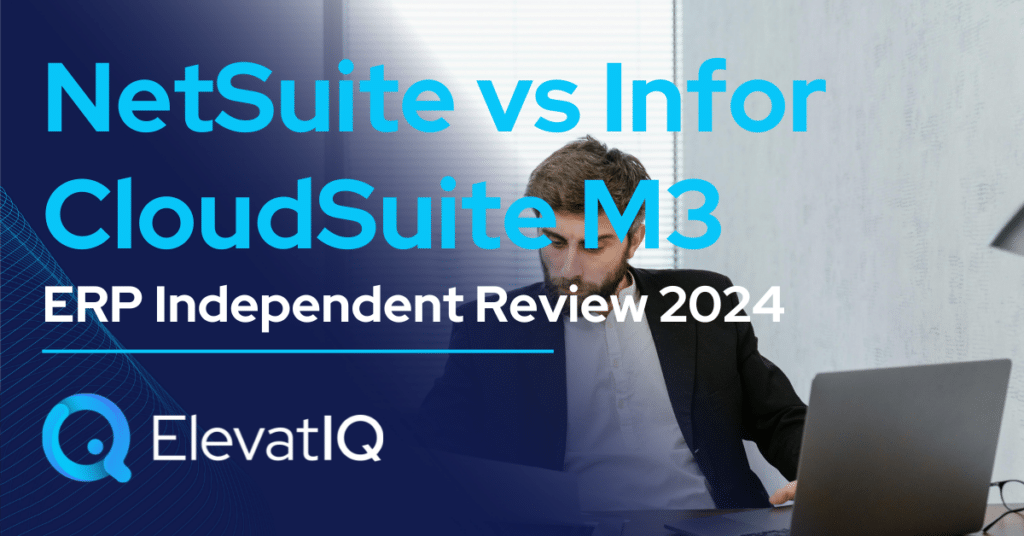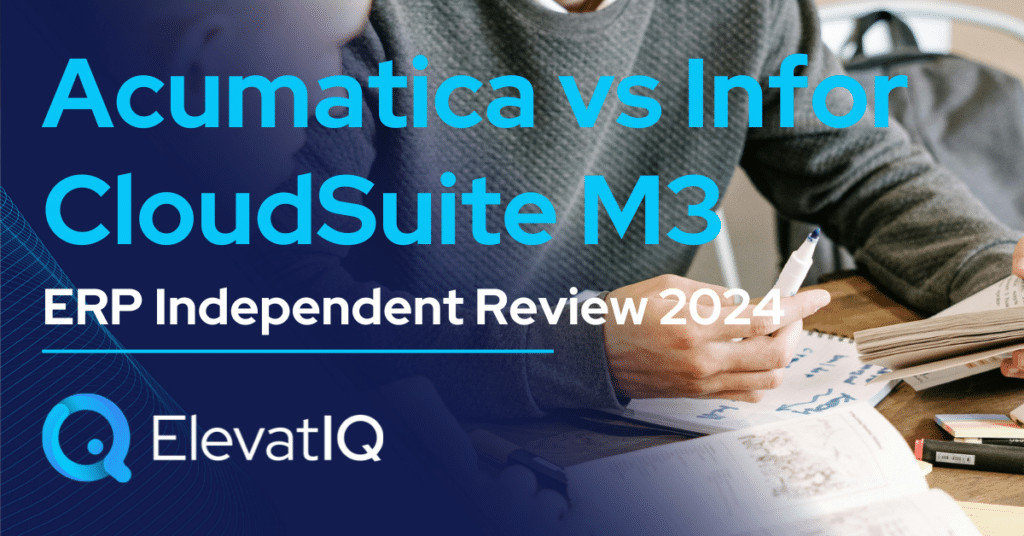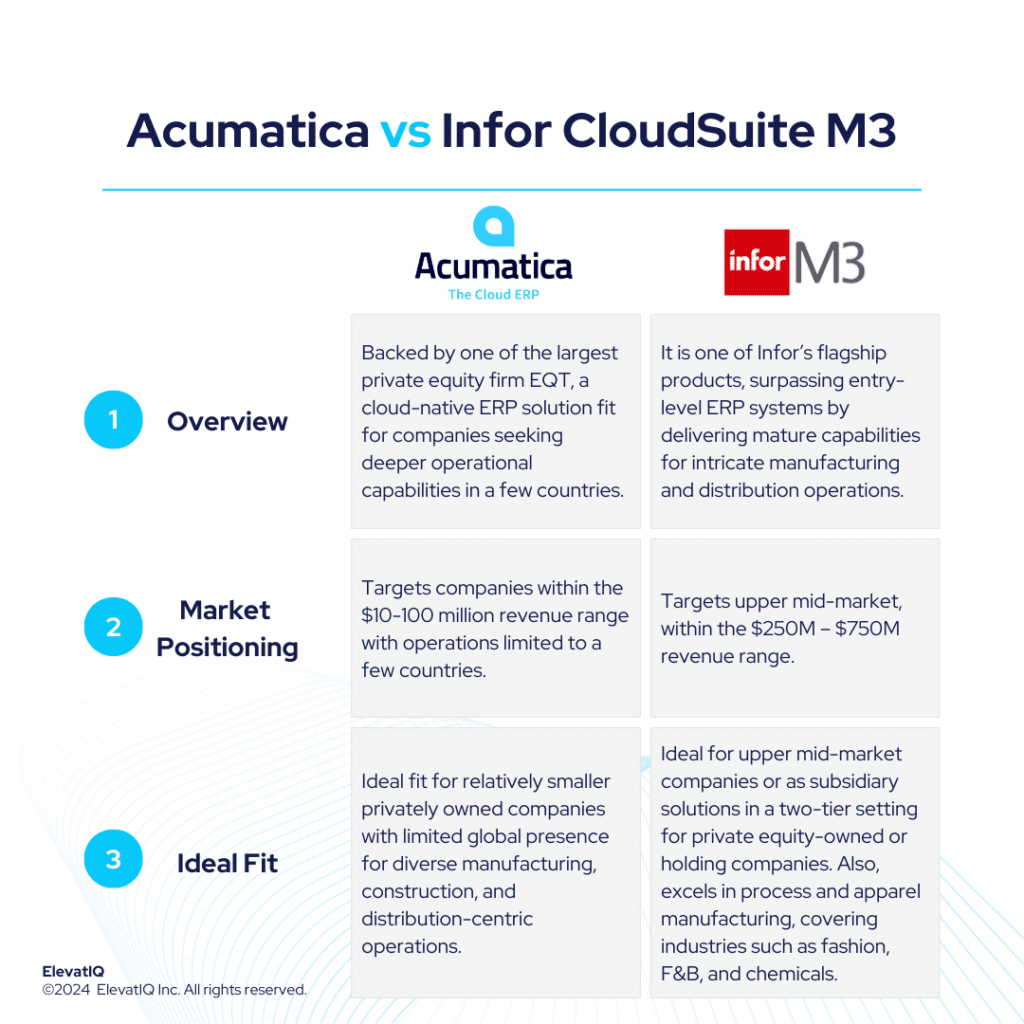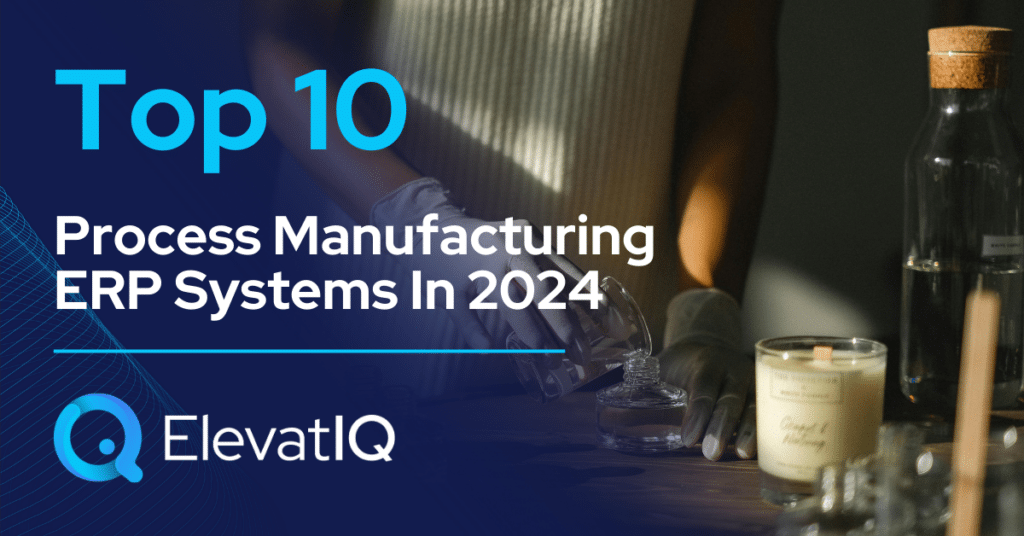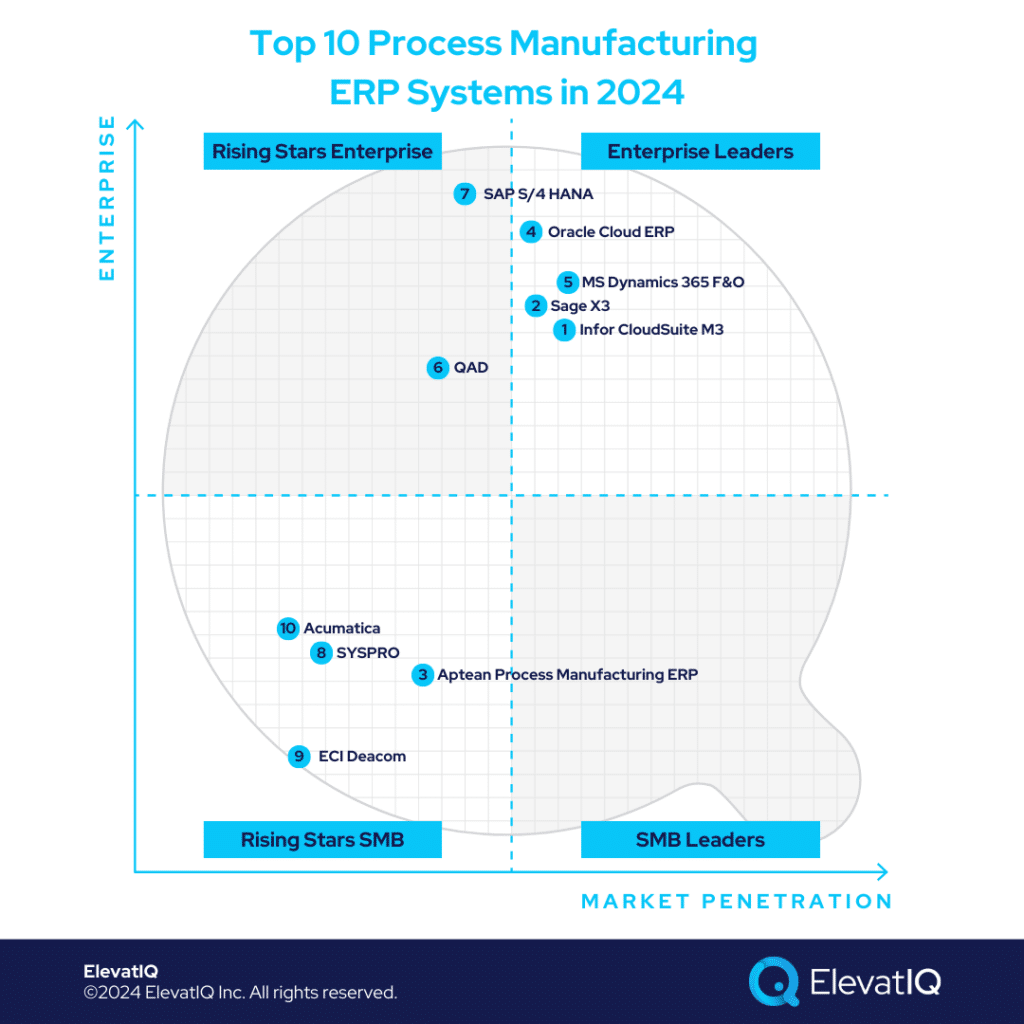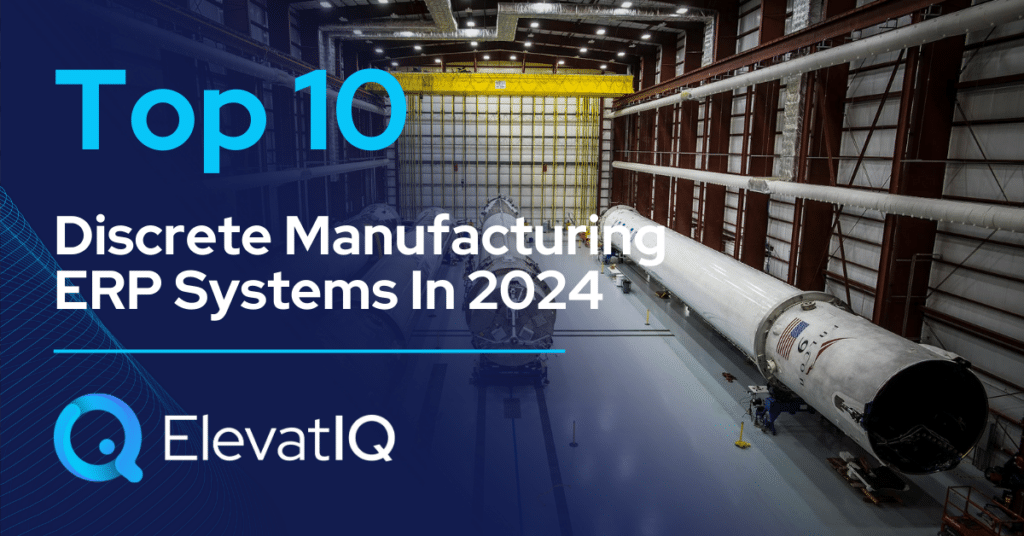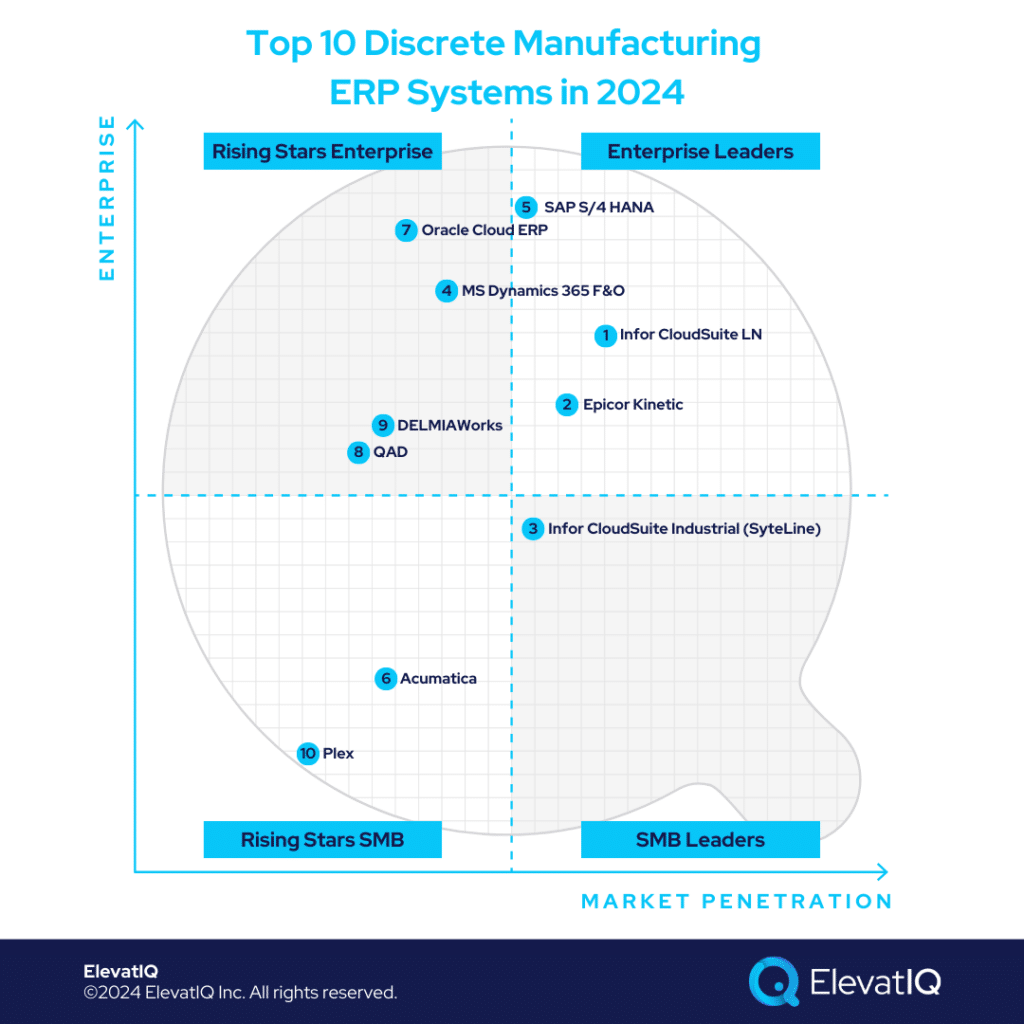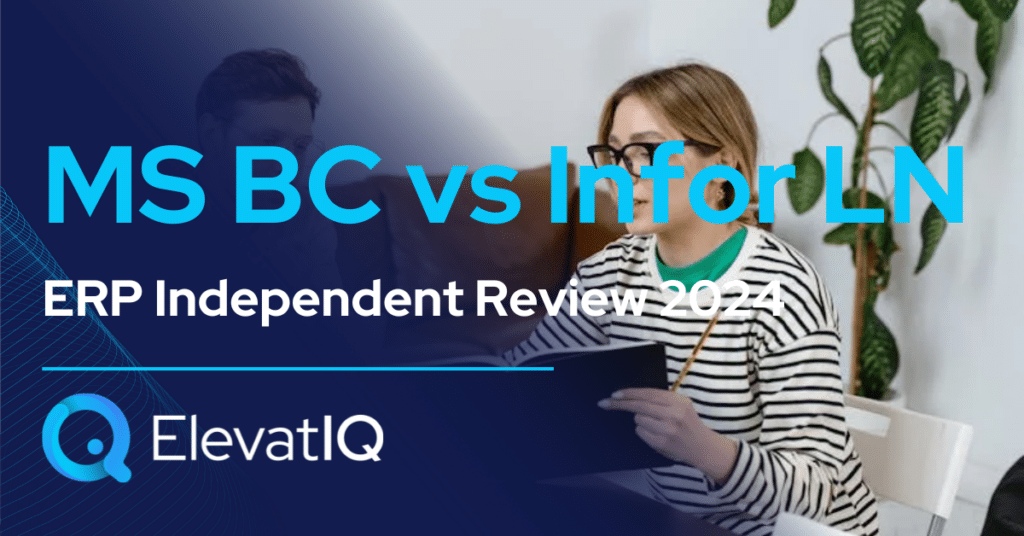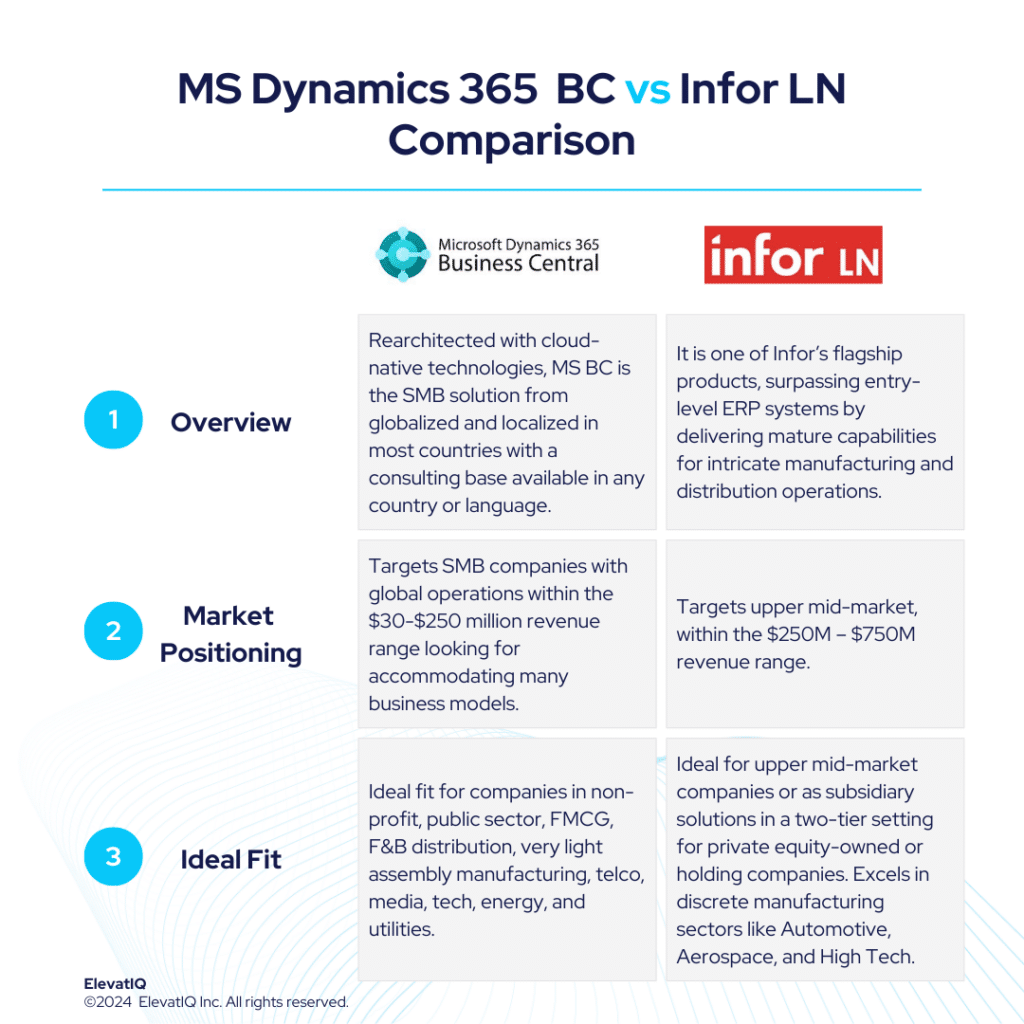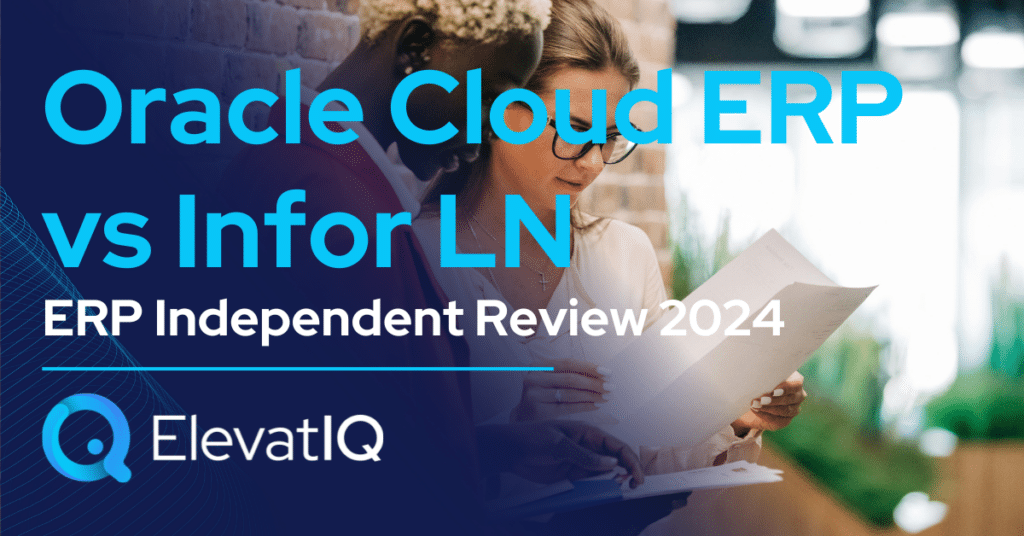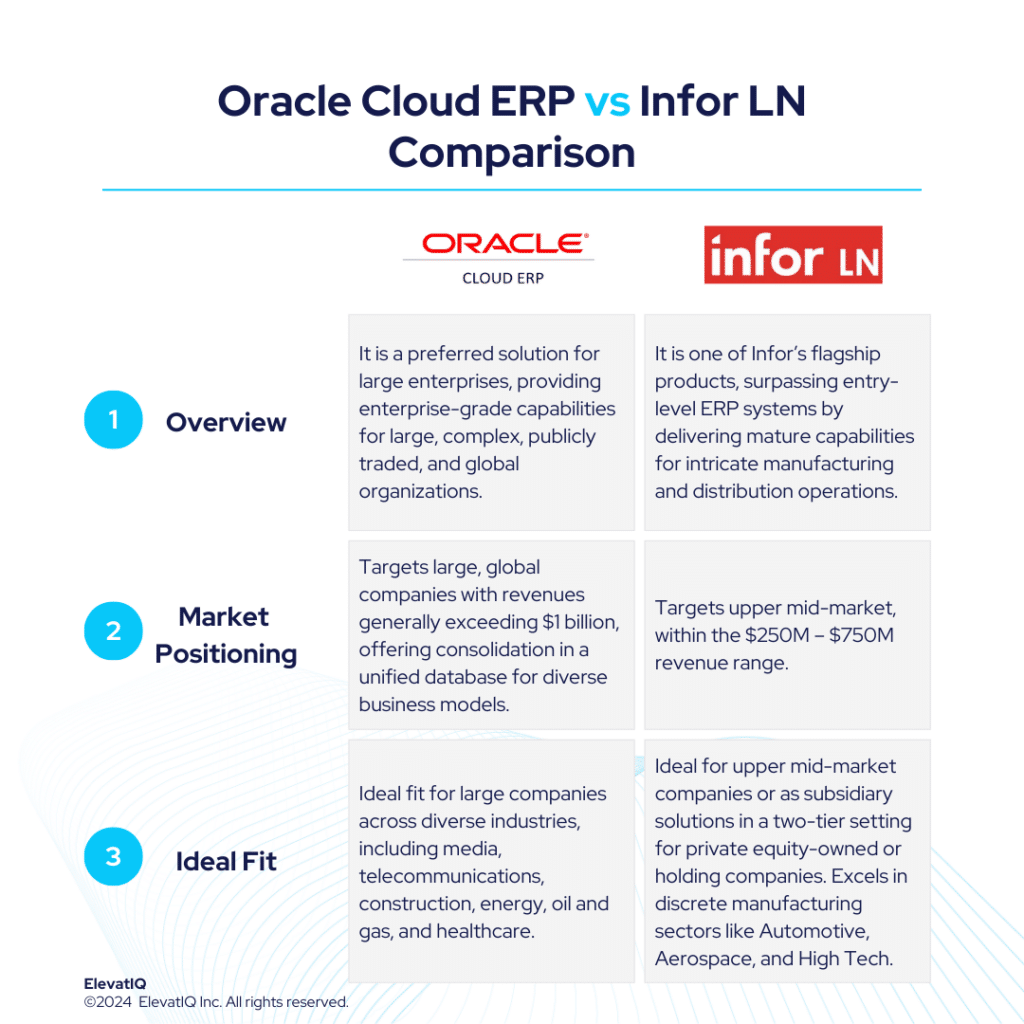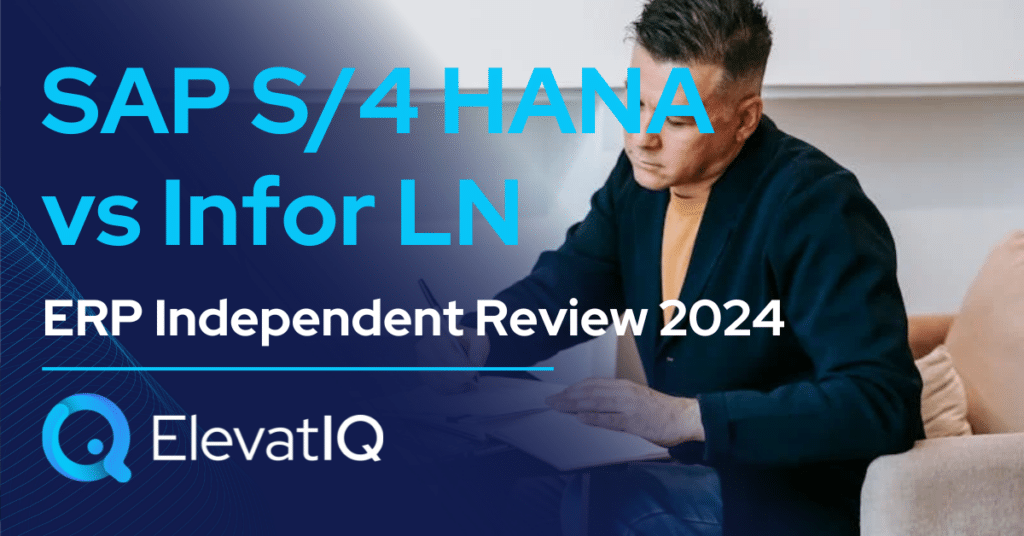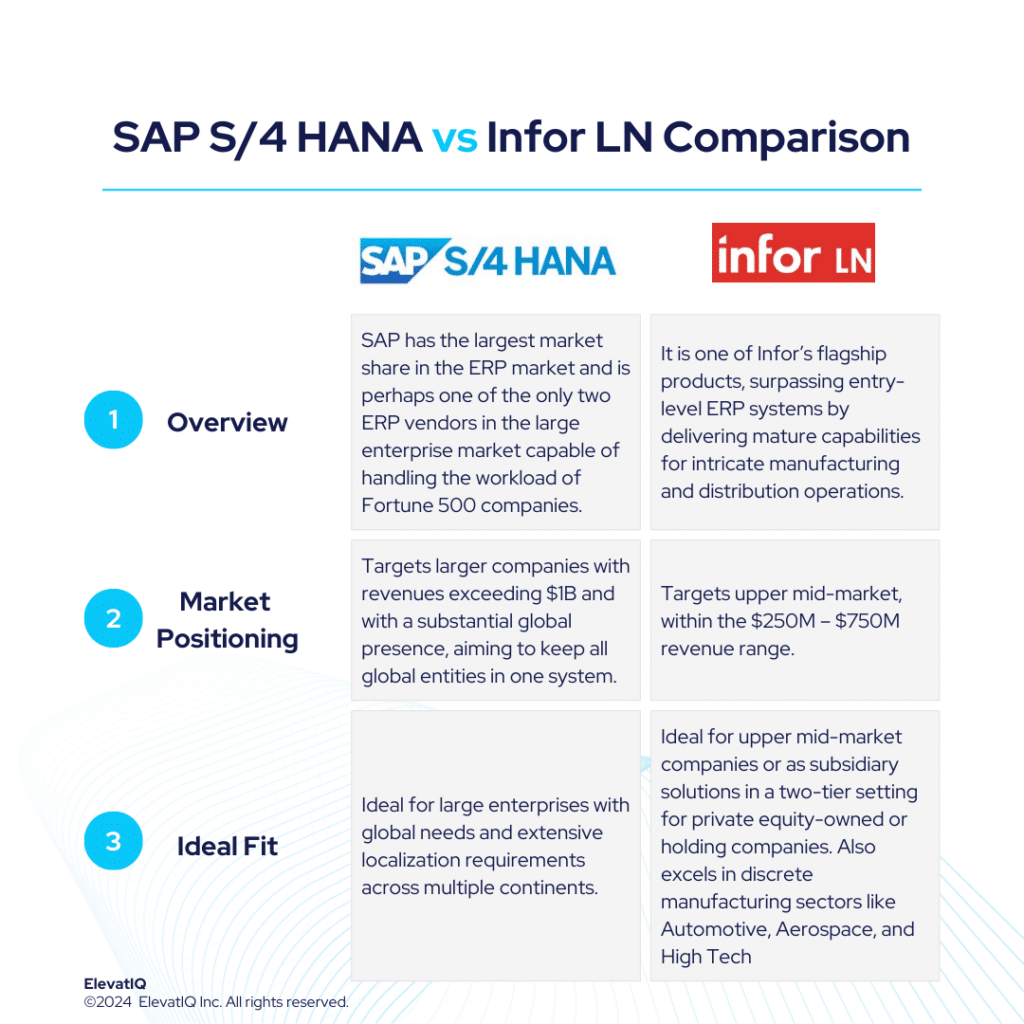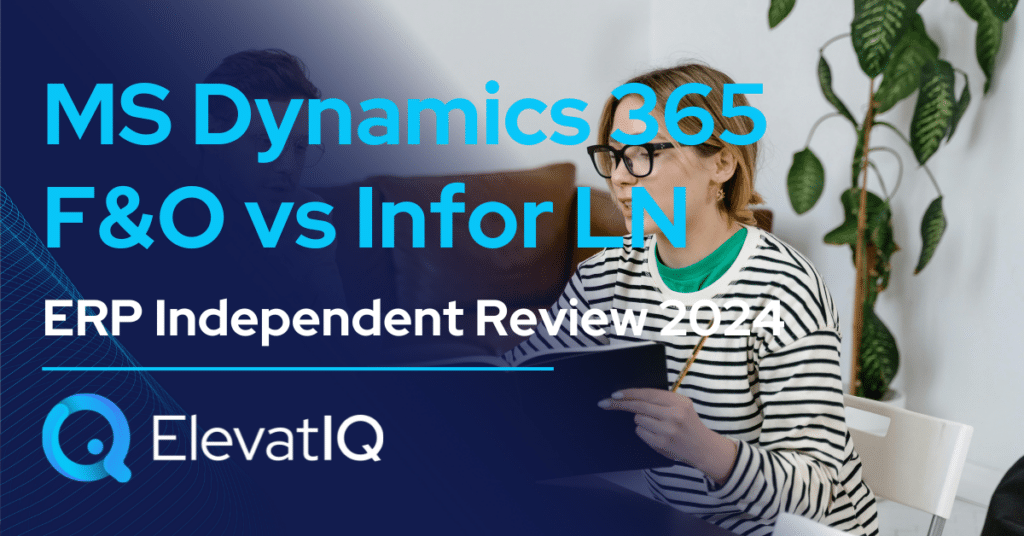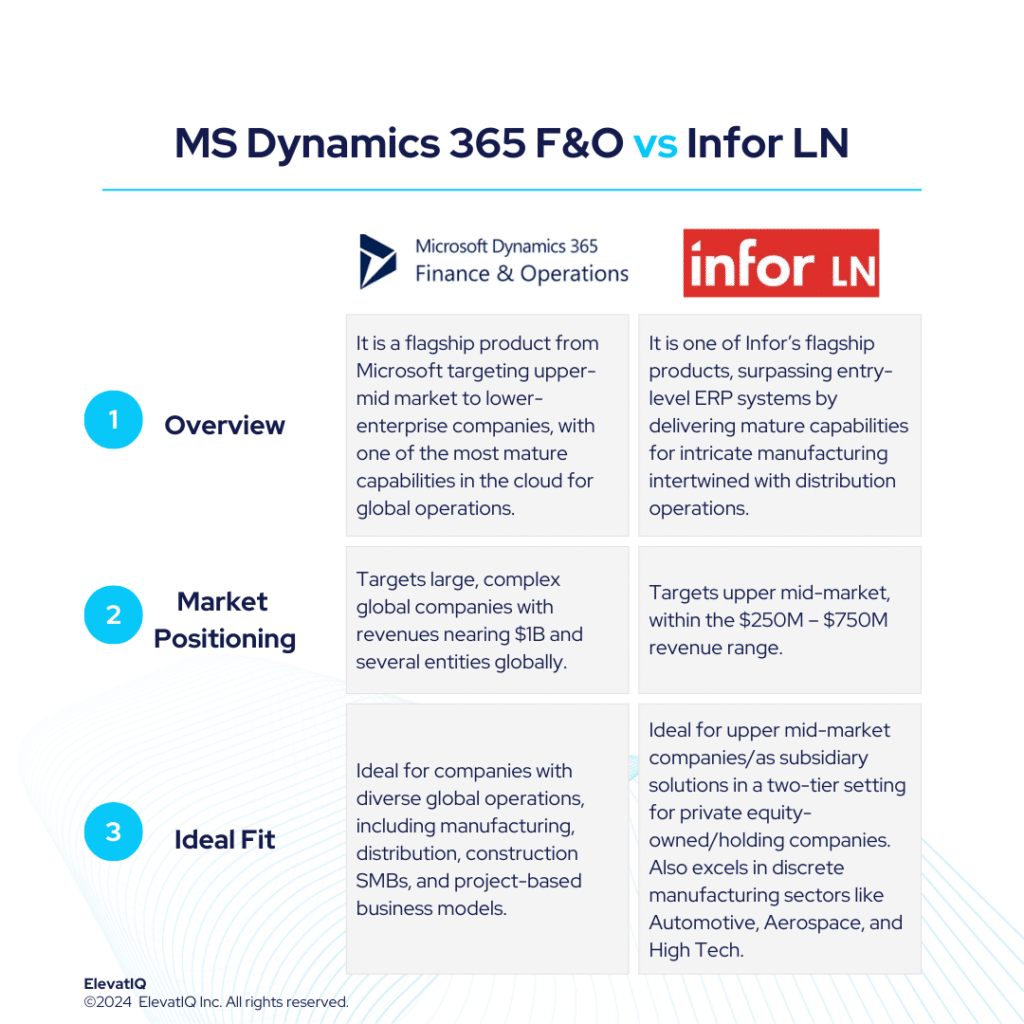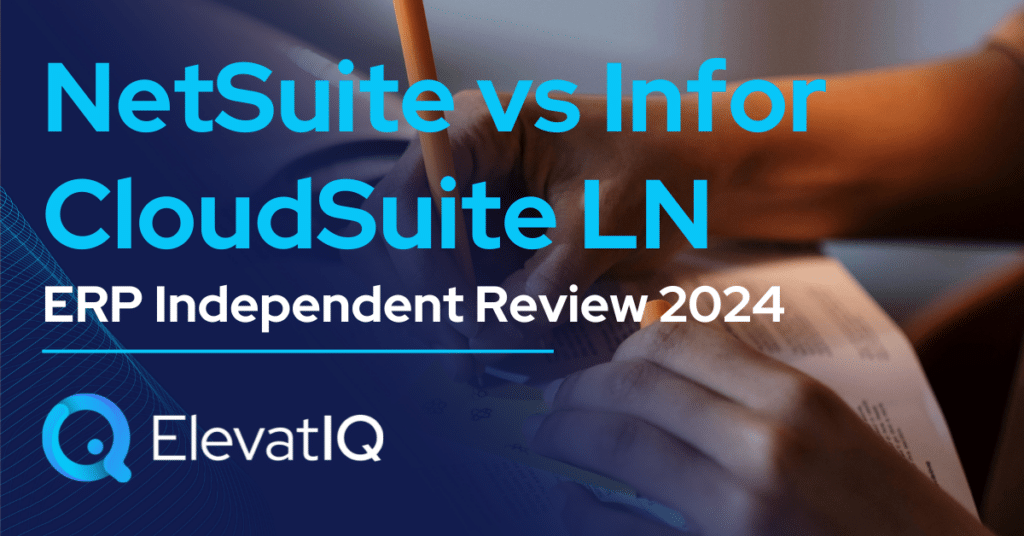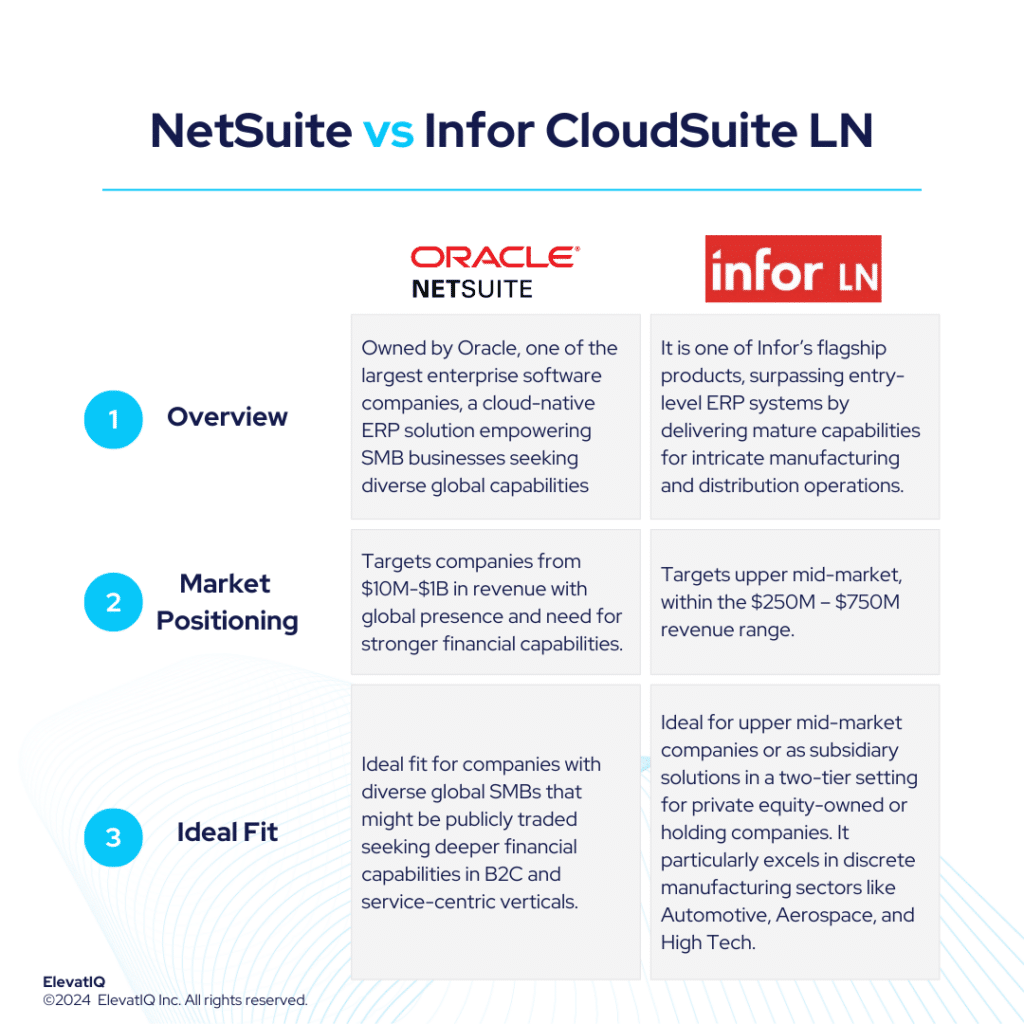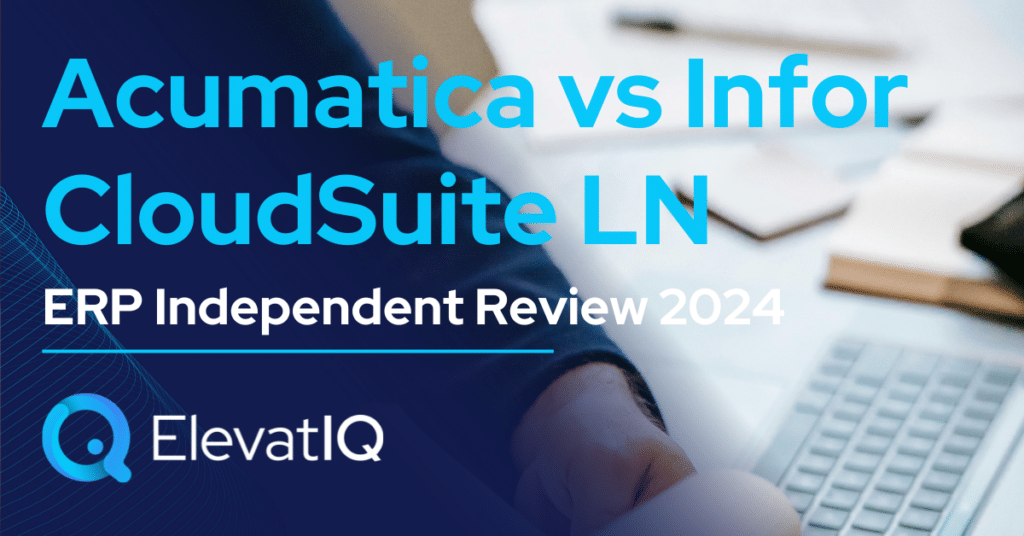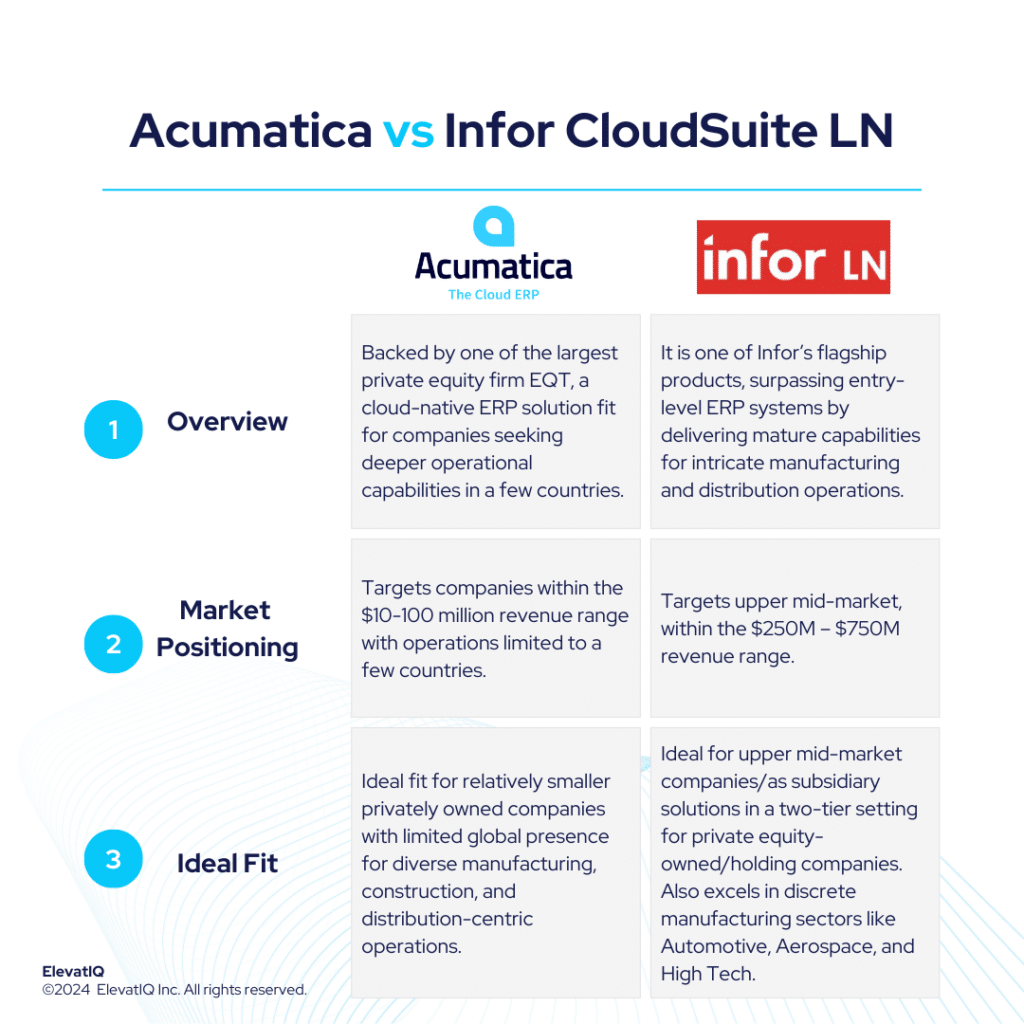NetSuite vs Infor CloudSuite M3 ERP Independent Review 2024
NetSuite caters to globally dispersed small to mid-market firms, offering robust financial capabilities and localization across many countries. On the other hand, Infor CloudSuite M3 targets companies surpassing entry-level ERP systems like Acumatica, Infor CSI, or NetSuite. It also delivers mature capabilities for intricate manufacturing and distribution operations. NetSuite suits diverse businesses, including service-centric, distribution-centric, and B2C organizations. Whereas, Infor CloudSuite M3 is successful in the upper mid-market, targeting the $250M – $750M revenue range.
Infor CloudSuite M3 provides a superior suite experience akin to SAP and Oracle, featuring enterprise-grade best-of-breed functionalities, including PLM, WMS, WFM, BI, and a Supply Chain collaboration platform. On the other hand, NetSuite supports lighter manufacturing and consumer products, particularly in health, beauty, fashion, and CPG. It also targets firms with revenues between $10M and $1B, emphasizing stronger financial capabilities.
Infor CloudSuite M3 boasts extensive features tailored for process and apparel manufacturing, covering industries such as fashion, F&B, and chemicals. It is also adept at facilitating advanced global operations, particularly for companies spanning multiple countries seeking to optimize cost synergies globally. Choosing between NetSuite vs Infor CloudSuite M3 requires a detailed examination, and thus, this comparison offers valuable insights for ERP selection projects. Therefore, let’s explore further.
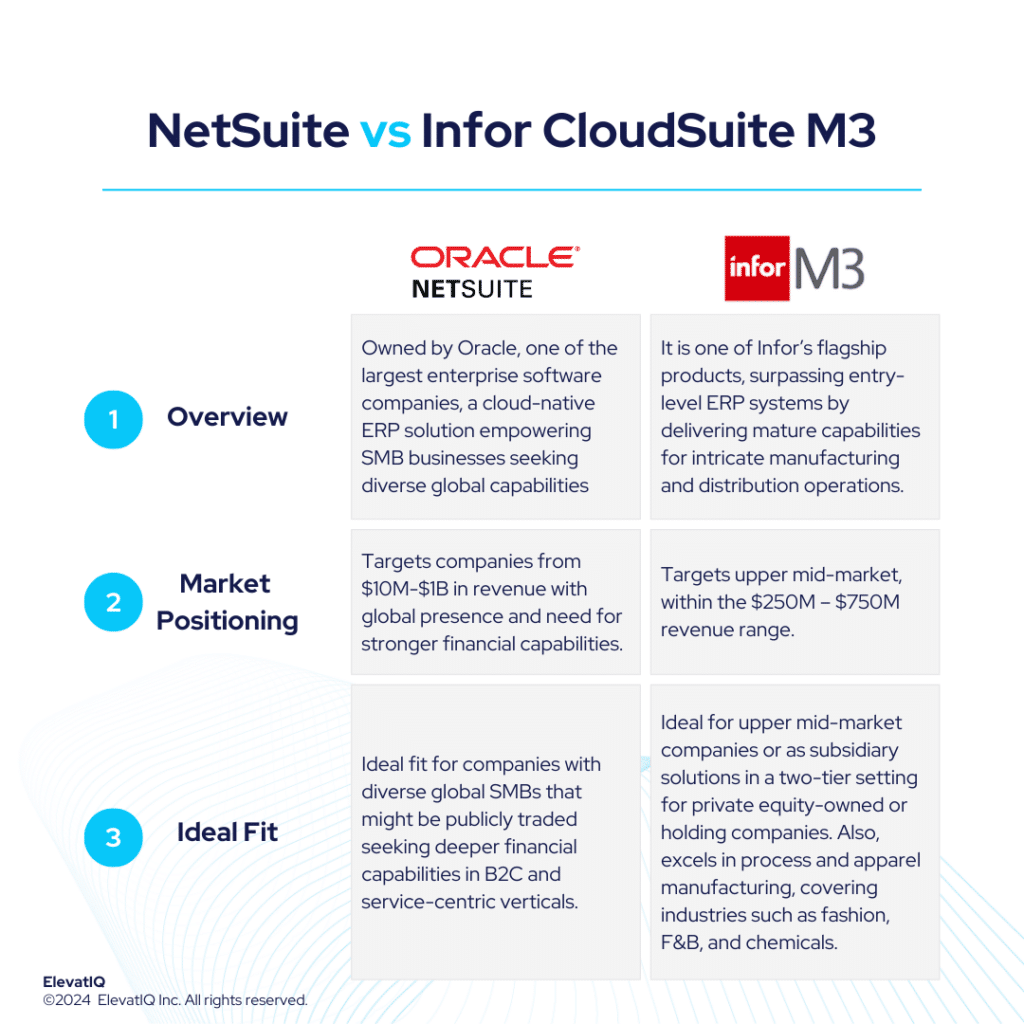

| NetSuite | Infor CloudSuite M3 | |
| Started in | 1998 | 2006 (Acquired by Infor) |
| Ownership by | Oracle in 2016 | Koch Industries |
| No. of customers | 37,000+ | 1000+ |
What is NetSuite?
NetSuite stands out as the leading ERP solution, driven by its success for diverse industries particularly seeking stronger financial capabilities over the operational, robust ecosystem, credible marketplace add-ons, and comprehensive functionality. Although not as complex as some competitors like SAP S/4 HANA and Microsoft F&O, NetSuite excels in supporting diverse business models, including omnichannel architecture, matrix/dimensional inventory, and subscription-based models.
While NetSuite excels across industries, it may not be the ideal choice for industrial distributors and manufacturers due to limitations in pricing and item master capabilities. Its strength lies in supporting lighter manufacturing and consumerized products particularly health and beauty, fashion, apparel, and CPG. With robust financial capabilities and an integrated HCM solution, NetSuite is well-suited for service-centric industries, including smaller banks, credit unions, financial services, non-profit organizations, as well as the technology and media sectors. While NetSuite remains the top-ranked solution due to its product quality, there might be challenges with over-customization and integration issues, leading to implementation failures. Thus, working with NetSuite demands thorough vetting of their solution and architecture.
What Is Infor CloudSuite M3?
Infor CloudSuite M3, is one of Infor’s flagship solutions, catering to particularly distinct micro-verticals across various industries. Sharing similar suites with Infor LN and built on the Infor OS platform, it is successful in the upper mid-market, targeting the $250M – $750M revenue range. Positioned for companies surpassing entry-level ERP systems like Acumatica, Infor CSI, or NetSuite, this solution delivers mature capabilities for intricate manufacturing and distribution operations. Infor CloudSuite M3 provides a superior suite experience akin to SAP and Oracle, featuring enterprise-grade best-of-breed functionalities, including PLM, WMS, WFM, BI, and a Supply Chain collaboration platform.
Infor CloudSuite M3 boasts extensive features tailored for process manufacturing and apparel manufacturing, covering industries such as fashion, F&B, and chemicals. It is also adept at facilitating advanced global operations, particularly for companies spanning multiple countries seeking to optimize cost synergies globally. The native capabilities of Infor M3 address global trade and compliance concerns, which are crucial for international business operations.
While Infor CloudSuite M3 serves as an excellent operational solution for a 2-tier architecture for enterprise companies, its limited focus on certain industries might not be the best fit for enterprise companies diversifying their operations or aggressive with their M&A strategy. The intricate data model and Bill of Materials (BOM) demand significant internal expertise and external advisory assistance to extract operational efficiencies. Notably, the technology landscape for Infor CloudSuite M3 remains somewhat patchy and less modern compared to its competitors. Furthermore, the ecosystem and consulting support for this solution is relatively limited. Despite these challenges, Infor CloudSuite M3 stands out as a robust manufacturing solution for upper mid-market companies with budget constraints.
NetSuite vs Infor CloudSuite M3 Comparison
Navigating the choice between NetSuite vs Infor CloudSuite M3 is a significant decision for businesses particularly looking for operational efficiency and strategic alignment. Thus, this section delves into the comprehensive comparison of NetSuite vs Infor CloudSuite M3 across various critical dimensions.
| NetSuite | Infor CloudSuite M3 | |
| Global Operational Capabilities | Handles global multi-entity operations but not suitable for enterprise workloads. | Robust financial hierarchies and global trade compliance functionality integrated. |
| Diverse Capabilities | Favors B2C, hospitality, and service-centric industries. | Supports diversified manufacturing business models. |
| Best-of-breed Capabilities | Contains pre-integrated HCM and FP&A components with varying maturity. | Best-of-breed integrations provided out-of-the-box. |
| Last-mile Capabilities | Limited last-mile capabilities, especially for manufacturing. | Last-mile capabilities along with breadth of capabilities for diversified manufacturing business models. |
| Operational Functionalities | Richer financial capabilities over operational features. | Infor CloudSuite M3 is a legacy solution with limited cloud-natve capabilities such as universal search, mobile experience, etc. |
| Integration Capabilities | Offers several pre-integrated solutions with more options from Celigo. | Tools such as HCM, PLM, data lake, ERP, WMS, TMS, and advanced supply chain planning, are all pre-integrated. |
| Manufacturing Capabilities | Limited BOM layers for assembly-centric operations, requiring additional add-ons. | Delivers mature capabilities for apparel, F&B, and chemical manufacturing. |
| Pricing Model | Named-user based with inflexible long-term contracts. | Subscription-based |
| Key Modules | 1. Financial Management 2. Accounting 3. Global Business Management 4. Inventory Management 5. Order Management 6. Supply Chain Management 7. Warehouse Management 8. Procurement 9. Customer Relationship Management | 1. Financial Management 2. Manufacturing Operations 3. Enterprise Asset Management 4. Supply Chain Management 5. Customer Sales and Service 6. Application Foundation |
NetSuite vs Infor CloudSuite M3 Feature Comparison
Both platforms offer a plethora of features and functionalities designed to streamline business operations and enhance efficiency. In this feature comparison, we delve into particularly the distinct capabilities of NetSuite vs Infor CloudSuite M3 across various critical dimensions, providing insights to aid businesses in making informed decisions regarding their ERP selection. Thus, this section discusses features under each of the following modules, particularly financial management and supply chain management.
Financial Management Comparison
In this section, we are discussing a detailed comparison of the financial management capabilities particularly offered by NetSuite vs Infor CloudSuite M3. By examining their respective strengths and functionalities, particularly in managing financial processes. Businesses can therefore gain valuable insights to determine the best-suited ERP solution for their financial management needs.
| NetSuite | Infor CloudSuite M3 | ||
| Financial Management | General Ledger | Supports complex general ledgers including public reporting requirements of several countries | Enables organizations to manage financial transactions, maintain accurate balances, and generate complete financial statements. |
| Accounts Receivable and Accounts Payable | Automates and streamlines invoice delivery, payment processing, and collections management as well as accounts payable processes. | Supports analysis across all accounting dimensions, including non-reconciled data for the AP model. | |
| Cash Flow Management | Provides visibility to optimize cash flows, monitor bank accounts, and manage liquidity. | Provides complete control over accounts receivable and cash flow processes, unifying all AR information to monitor cash collection and enhance productivity and efficiency. | |
| Tax Management | Manages domestic and global tax, generates detailed reports, and analyzes transactions real-time. | Ensures accurate VAT calculation and recording for each country, automating tax calculations based on recipient location and country-specific rules, and maintaining financial compliance. |
Supply Chain Management Comparison
In this comparison, we explore and analyze the supply chain management capabilities of NetSuite vs Infor CloudSuite M3, shedding light particularly on their respective strengths and weaknesses.
| NetSuite | Infor CloudSuite M3 | ||
| Supply Chain Management | Warehouse Management | Provides the ability to optimize day-to-day warehouse operations, eliminate manual processes and minimize handling costs. | Optimizes operations with inventory management, labor management, 3PL billing, and 3D visualization, enhancing efficiency and interactivity. |
| Inventory Management | Automates inventory management processes with multi-location fulfilment, cycle counting, replenishment, traceability and item visibility. | Provides advanced statistical forecasting and stock recommendations for efficient inventory management, as well as supplier and customer rebate management to maintain high margins. | |
| Procurement | Streamlines procurement processes with source management, purchase management, vendor management and invoice processing. | Manages purchase activities and maintains the resulting data. | |
| Supply Chain Planning | Provides the ability to analyze demand, determine replenishment requirements, add stock and create orders according to an up-to-date supply plan. | Supplies planning capabilities are one of the robust for global manufacturing operations including most of the Supply Chain suite components pre-integrated as part of the suite. | |
| Supply Chain Execution | Optimizes all supply chain assets, controls costs at each step. | Supplies execution capabilities are one of the robust for global manufacturing operations including most of the Supply Chain execution components pre-integrated as part of the suite. |
Pros of NetSuite vs Infor CloudSuite M3
When evaluating ERP solutions, understanding the distinct advantages of NetSuite vs Infor CloudSuite M3 is crucial. In this section, we are particularly exploring the strengths of NetSuite vs Infor CloudSuite M3 across various dimensions. Thus, shedding light on their respective capabilities and functionalities.
| NetSuite | Infor CloudSuite M3 |
| Provides richer financial capabilities over operational, with leaner operational layers built with the product. | Ideal for upper mid-market companies or as subsidiary solutions in a two-tier setting for private equity-owned or holding companies. |
| Ideal for SMBs operating in different countries, but operational and supply chain planning might be limited for companies seeking global operational synergy. | It can support the most complex manufacturing business models, WBS-centric manufacturing, or support for attributes with MRP planning. |
| The data model is B2C friendly, supporting integration with B2C channels. | Most tools that make-to manufacturer would require, such as HCM, PLM, data lake, ERP, WMS, TMS, and advanced supply chain planning, are all pre-integrated with Infor CloudSuite M3. |
| Ideal for eCommerce-centric SMBs because of the ecosystem and the integration operations available for eCommerce-centric companies. | While most smaller solutions might require ad-hoc arrangements for global financial operations, Infor CloudSuite M3 has them natively built. |
Cons of NetSuite vs Infor CloudSuite M3
Just like recognizing strengths is important, it’s also crucial to weigh the specific drawbacks of NetSuite vs. Infor CloudSuite M3. Therefore, in this section, we will delve into the limitations and challenges associated with NetSuite vs. Infor CloudSuite M3 across various operational and financial dimensions.
| NetSuite | Infor CloudSuite M3 |
| Not a great value for companies operating only in a few countries. | The limited focus on certain business models poses the risk of requiring other ERP systems to support complex and diverse business operations. |
| May struggle with transactional workload requirements of companies over $1B and the ones that might be acquiring 10-20 entities every year. | Private equity and holding companies requiring global solutions with a tier-2 solution at the subsidiary level might not be the best use of Infor CloudSuite M3’s strengths. |
| Not ideal for startups with simpler operating models. | Infor CloudSuite M3 is a legacy solution with limited cloud-native capabilities such as universal search, mobile experience, etc |
| Named-user-based pricing requires allocating fixed costs, even for seasonal workers or external users accessing the subset of data such as customer or vendor portals. | The consulting base and marketplaces are virtually non-existent for Infor CloudSuite M3. |
| Not fit for companies seeking OEM-owned integration with core operational systems such as CAD or PLM. | Verticals such as apparel manufacturing demand deeper integration of PLM, vendor portals, and merchandising solutions to effectively manage their unique processes. |
Conclusion
In conclusion, choosing between NetSuite vs Infor CloudSuite M3 largely depends on a company’s specific needs and market positioning. NetSuite, owned by Oracle, offers a cloud-native ERP solution particularly designed for globally dispersed small to mid-market firms with revenues ranging from $10M to $1B. Its strength lies in its robust financial capabilities, making it ideal for B2C, service-centric industries, and companies particularly requiring strong financial management and localization. However, its limitations in supporting intricate manufacturing operations and its challenges with over-customization must be carefully considered. NetSuite’s ecosystem, integrated HCM, and focus on lighter manufacturing and consumer products make it a strong contender for diverse business models but might not suit enterprises with complex manufacturing needs.
On the other hand, Infor CloudSuite M3 caters to upper mid-market companies with revenues between $250M and $750M, surpassing entry-level ERP systems with mature capabilities tailored for intricate manufacturing and distribution operations. Positioned as a robust solution for industries such as fashion, F&B, and chemicals, Infor CloudSuite M3 excels in process and apparel manufacturing and supports advanced global operations with extensive last-mile and best-of-breed capabilities. Despite its strengths, the limited consulting base, patchy technology landscape, and focus on certain industries may pose challenges for companies with diverse or aggressive M&A strategies.
To get a 360-degree view of feature comparisons, it’s essential to explore not only NetSuite vs. Infor CloudSuite M3 but also insights from other analyses such as NetSuite vs. Acumatica, SAP S/4 HANA, Oracle Cloud ERP, MS Dynamics 365 F&O, and MS Dynamics 365 BC. Also, seeking assistance from an independent ERP consultant can significantly aid the decision-making process, offering specialized advice and direction tailored to the specific needs of the business.

FAQs
NetSuite vs Infor CloudSuite M3 ERP Independent Review 2024 Read More »

